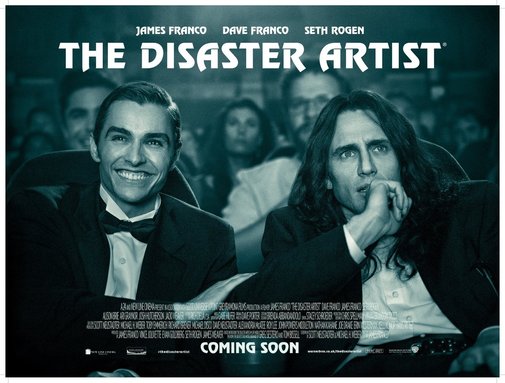By Spencer Coile
Tommy Wiseau's The Room is a train-wreck. This is not a unique statement to make. Ask anyone who has seen it, and you'll surely be met with a healthy mix of laughter and endless quoting from 2003's "so bad it's good" disasterpiece. For years, fans have flocked to midnight showings at local theaters or gathered with friends around their TV to enjoy the messy writing, acting, and directing -- just three of the many hats Wiseau wore throughout filming.
What many fail to address, however, is that The Room was not always comedy; it began as a labor of love -- a melodrama with strong connections to Wiseau's personal (but very private) life. Adapted from the memoir by The Room co-star Greg Sestero and journalist Tom Bissell, James Franco dramatizes Wiseau's journey from obscurity to cult stardom in The Disaster Artist. But is his portrayal of Tommy Wiseau given the same loving treatment as Wiseau intended for The Room...?
The Disaster Artist opens with a slew of famous actors (Kristen Bell, Adam Scott, Lizzy Caplan, and Keegan-Michael Key to name a few) commenting on The Room's pervasiness within popular culture. Many remark that it has reached a cult status that rivals "good" films. From there, the title card appears on screen with the "based on a true story" tacked underneath -- and thus, the story begins. This meta opening serves as a reminder to fans of The Room's cultural influence, but what purpose does this serve for those who are unfamiliar with Wiseau's original?
This question is never fully addressed in Franco's vision. The direct commentary on Hollywood and filmmaking that the opening suggests is never picked up again. Instead, we are immediately thrown into the friendship between Tommy Wiseau (James Franco) and Greg Sestero (Dave Franco). They meet in an acting class in San Francisco, and neither of them is particularly gifted. Greg is too reserved, Tommy is the exact opposite -- performing a piece from A Streetcar Named Desire where he shouts "Stella!" endlessly, while also writhing on the ground and thrusting his hips into the air. When the two agree to move to Los Angeles to pursue serious acting careers, it becomes abundantly clear that neither has the chops to be the artist they think they should be.
In one quick and comedic montage, Tommy writes The Room, pitches it to Greg, and the two begin making the "greatest bad film ever made." The Disaster Artist skims over this period, although according to the time cards onscreen, this process takes almost two years to complete. This is an odd choice. The film seems fascinated by Wiseau and what makes him tick, so it would be worth exploring his inspiration for making The Room in the first place. However, once the screenplay for The Room is written, Franco (as director) hits the ground running and never looks back.
What could have been an interesting examination of Wiseau's strange and twisted mind soon just becomes one big inside joke. Countless scenes feature Wiseau attempting to bring his dramatic vision to life, but these scenes mostly play like a wink to fans of The Room, rather than a deep dive into the actual story of the process of making the cult classic.
Fortunately, I had seen the 2003 inspiration behind The Disaster Artist but I went with friends who had not seen The Room. Needless to say, they were not in on the joke. And therein lies the biggest flaw in The Disaster Artist -- in his attempts to make us laugh at all of Wiseau's eccentricities while simultaneously giving us space to sympathize for him, Franco as a director missed the mark to offer more than a superficial glance of Wiseau.
That said, Franco as an actor deserves a large amount of credit for his work in front of the camera with his portrayal of the enigmatic Tommy Wiseau. Throughout the film, everyone asks questions about him: Where is he from? How can he afford to pay for this film out of his own pocket? How old is he? The film suggests that we are still asking these questions (though many myths about his origins and age have been debunked). And although the screenplay and direction offer little in the way of humanizing Tommy, Franco's performance is not only bemusing, but heartfelt. From every mannerism, awkward chuckle, and glazed over expression, Franco works to make Wiseau more than just a caricature.
It's a shame that none of the other roles are given the same attention, especially given the cast The Disaster Artist has assembled! Ari Graynor, Josh Hutcherson, Jacki Weaver, Zac Efron, June Diane Raphael, and Nathan Fielder all give solid impressons of the actors portrayed in The Room. Meanwhile, Seth Rogen, Megan Mullally, Casey Wilson, Hannibal Burress, Allison Brie, Sharon Stone (in one heinous wig), Melanie Griffith, and Bob Odenkirk are all saddled in thankless roles that, had their roles been more significant, could have made The Disaster Artist an undeniable contender for Best Ensemble at SAG. Still, though, they're clearly having fun, which perhaps was the point all along.
I found myself laughing a lot throughout The Disaster Artist; it's hard not to. Even my friends who had never seen The Room chuckled along somewhat. The film is something of a crowdpleaser -- it speeds through its quick runtime and ends on an optimistic (albeit, historically inaccurate) note. Regardless, I couldn't help but wish Franco (as director) had devoted less time at the end juxtaposing clips from The Room with reenactments from The Disaster Artist and more time digging deeper into the beguiling past of Tommy Wiseau.
Grade: B-


